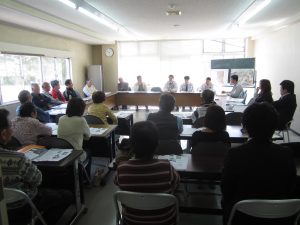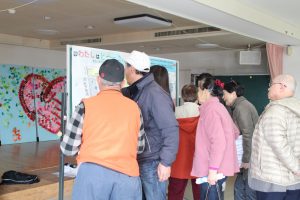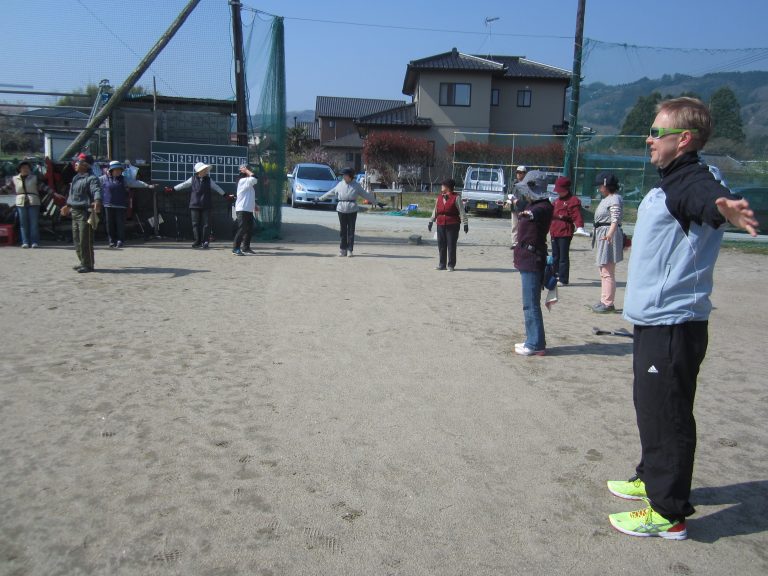This piece is the fourth part in the JAWS online series of Reflections from Tōhoku
“And what does your husband do while you’re doing the research?”
“He’s a full-time house-husband (sengyōshufu, pronunciation the same as full-time housewife)”
For my research into long-term community reconstruction after the 3.11 during my PhD, I conducted field research for a period of eight months in the town of Yamamoto in Tohoku in 2014–2015. While my research required actual travel from home to a distant field, the heydays of presenting the heroic ventures of a solitary fieldworker in ethnographic tradition are long gone. The field nor the fieldwork cannot be separated from other experiences and periods in our lives and the researcher is contributing to the construction of the field with his or her presence through meddling of the personal and professional roles. These roles are mutually constitutive with fieldwork engagements and reflections of one’s positionality can serve as a spark for analytical insights (Amit, 1999).
My personal life followed me to my fieldwork rather concretely, because my husband decided to take a sabbatical year from his work to accompany me to Tohoku. His long leave from work and my description of him as full-time house-husband created feelings of both amusement and amazement in my research participants and I heard occasional curious inquiries about which one of us was responsible for cooking or household chores. The way my agency, position and role were constructed not only in relation to the locals, but also to my husband, made me reflect the observations I made about the impact of gender in the recovery context. In this paper, I discuss a few of these observations on how women, despite of their allegedly disadvantaged position in both disaster aftermath and Japanese society on the whole, seemed to be able to enhance their social recovery through their gendered activities.

Warming up before playing ground golf with the locals. Towards the end of the fieldwork, also my husband was invited to and accompanied me to various activities in Yamamoto (All photos Pilvi Posio 2015)
Tohoku’s overwhelmingly rural character raises issues of gender perhaps even more to the surface as stereotypical gender roles have remained associated strongly with the countryside (Vainio, 2019). Broadly summarised, the gender role division within the household and consequently in the society is argued to be based on the ie family model, institutionalized by the Meiji government. Women’s role was reduced to household maintenance and motherhood, while the formally abolished yet still prevailing ie ideology ensured patriarchal power that later translated to men’s breadwinner role outside the home (Imamura, 2010). Such gendered ideas have remained to this day, something that I too came across in my contacts with local residents, making me reflect my role as a researcher and also as the perceived ‘breadwinner’ of the family. On one evening, I saw one of my research participants, Kaneko-san, a man in his 70s, working on the community vegetable field. I stopped to chat with him and received a bunch of onions and a variety of fresh greens “to have something to eat at home”. As we were talking, another resident unknown to me drove to the field. Kaneko-san laughingly introduced me to him as his daughter, “kochi wa musume, ne “. With my hands full of vegetables, I wondered, how this positioning of me as a young female in relation to older men affected my credibility as a researcher. In some ways such a position is an advantageous one, as being a young woman is argued to be, in fact, one of the best positions to study Japan as they are ideally “patronized” and “most likely to have the basic categories of how Japanese society operates ‘explained’ (‘mansplained?’) to them” (Goodman, 2020, p.31), with humorous Kaneko-san proving to be one of my key contacts in the end. Nevertheless, the constant self-reflection of my socio-demographic position, as well as the now well-known division of labour in my household during the fieldwork, made me pay attention to gender divisions in terms of agency and participation in disaster recovery even more acutely.
Disaster studies in general have found that gender disparities make women more vulnerable in disasters and long in their aftermath compromising their resilience, the capacity to recover from a crisis. This gender inequality in disaster is constructed by, for instance, women’s caregiver role and limited power in intra-household and community levels and often accentuated in times of crisis (e.g.Ashraf and Azad, 2015; Smyth and Sweetman, 2015). Japan generally ranks very low on the Global Gender Gap index (the 120th out of 156 countries) (World Economic Forum, 2021) and the gender role division in Japan has left women to rather powerless in the society at large, despite of their relative well-being and happiness (Steel, 2019). The national guidelines for reconstruction acknowledged this weak position of women and stressed the importance to include them in reconstruction process (Reconstruction Design Council, 2011). The gender aspect, however, has been mostly neglected in the Japanese disaster reconstruction context in practice and women have remained underrepresented in reconstruction planning councils both before and after the 3.11. in Yamamoto and Tohoku in general (Saito, 2014; Yamamoto, n.d.).


While reconstruction information events gathered women as more passive participants, men were the vast majority in machizukuri councils.
Thus, gender shapes also the types of agency and opportunities for participation one has in the post-disaster. My fieldwork took me to various community spaces and activities that ranged from machizukuri (community planning) meetings to lunch gatherings and exercise clubs. All of these were more or less dominated either by male of female participants depending on the activity. Both disaster resilience research (e.g. Norris et al., 2008) and official reconstruction plans in Japan and Yamamoto (Reconstruction Design Council, 2011; Yamamoto, 2011) advocate citizen participation as central means of recovery. In Yamamoto, the formal forums for citizen participation were the three town-initiated machizukuri councils (Posio, 2019b). With only few exceptions, the vast majority of the participants in machizukuri meetings and all the residential district leaders representing their neighborhood committees were elderly men. Hence, seemingly, as a continuation of their leading role in the household and community, the men appeared to have more opportunities to enhance their disaster resilience through participation in recovery activities. However, reconstruction planning in Tohoku was complicated in many ways, and although machizukuri councils offered a forum for participation, they often caused frustration because the participants felt that everything was already decided (c.f. Vainio, 2020).
Interestingly, however, many locals also noted that the disaster had made men more passive and secluded, due to increasingly many elderly men giving up farming and fishing after the disaster and thus losing their key social networks. Thus, while the formal citizen participation and decision-making was dominated by men, it did not provide general opportunities to reconstruct social networks that are today broadly considered essential for recovery and resilience (e.g. Aldrich and Meyer, 2015; Norris et al., 2008). While some men had found a channel to re-establish their social connections through organized community activities, the loss of men’s prior functional roles in the community through employment had made the task much harder. In a society where men tend to be defined through their work (e.g. Cook, 2016), even retirement has been found to often cause similar loss of social connections for Japanese men (Kawano, 2017). In Tohoku, men were in general perceived to have more difficulties in re-establishing their social life after the disaster, making them prone to seclusion, alcoholism and lonely deaths (cf. Gagné, 2020). The teacher of a regular soba noodle workshop in a temporary housing told that the participants in their meetings and other similar activities were all women. They said that the men were “sleeping at home”, which was taken as a sign of their depressed mood. To help these secluded men to re-establish their sense of usefulness, the leader of the local volunteer center described how he tried to give small tasks, such as changing a light bulb, to men residing in temporary housing.
The women, on the other hand, seemed more capable of capitalizing on their pre-disaster ways of socializing through food, handicrafts, exercise and chatter. A participant in the soba noodle workshop mentioned above stated that “women think about food” and added how “the sorrows go away for a moment when eating together.” As cooking and eating together and other joint activities, such as handicraft and exercise groups and casual teatime gatherings were already part of the regular social schedule for women in pre-disaster times, their social networks had remained more intact. When discussing these activities with the participants and organizers, many noted however that now these activities had a new meaning: exercise clubs had “become a forum of laughter and chatter”, while in handicrafts and lunch meetings “the faces of the participants gradually turned brighter when doing things together.” This positive effect had led to burgeoning of similar new activities and establishment of gathering places (Posio, 2019a). If elderly ladies enjoying cooking and chatter, also the needs of young women whose everyday life consisted of childcare duties were increasingly acknowledged. I participated in few activities of a group that aimed with their regular mother-child meetings at offering not only a safe place for children to play, but also a comfortable opportunity for young mothers to meet and socialize.


Women cooking together at lunch meeting (left). Exercise club at temporary house (right). Although many activities were not gender exclusive as such, women seemed to take part in activities such as cooking and exercising in greater number and felt that they gave a sense of social connections.
My positionality as a young female may have facilitated my access both to the male spaces as the “patronized” foreign female researcher and to feminine activities through my own gender, and these anecdotal observations offer a glimpse of gendered and partly age-related opportunities for enhancing social recovery. Throughout the fieldwork, my husband’s role and his somewhat limited cooking skills remained a joke between me and many of the locals I met. It was also a nice icebreaker in the interviews that also probed insights on gender roles. My husband himself remained mostly blissfully unaware of his positioning because of his lack of Japanese skills, but as noted, the perceived oddity of his position contrasted with how Japanese men tend to be strongly associated in the sphere of work life. The continuation of everyday practices associated with women’s role, such as cooking or childcare, offered both places and activities to strengthen women’s social networks and hence, support their social recovery. Furthermore, this also highlights the importance of understanding the gendered ways of how these social roles and relations are constructed in the first place when considering the means to facilitate social recovery and resilience.

Although my husband’s role as house-husband became somewhat a joke with the locals, rest assured that no masculine self-esteem was harmed during the fieldwork: He was able perform also his masculine role while residing in Yamamoto by doing manly men’s stuff, such as helping to establish manually a vegetable field in our landlord’s garden. Our landlord laughingly welcomed him to stay longer in Yamamoto than me and took him to play golf that was “men’s business”. I am indebted to my husband as he made my field research easier in many ways. And funnily enough, he is at the time of writing this really a full-time house-husband: Him being on paternity leave after our second child also enabled me to write this.
Pilvi Posio is a Doctoral Candidate at the Centre for East Asian Studies at the university of Turku, Finland. She is currently finishing her dissertation on long-term community recovery after the 3.11 in the town of Yamamoto. Her main research interests are anthropology of community, place and security as well as disaster recovery and collective action.
References
Aldrich, D. and Meyer, M. (2015) ‘Social Capital and Community Resilience’, American Behavioral Scientist, 59(2), pp. 254–269.
Amit, V. (1999) ‘Introduction: Constructing the field’, in Amit, V. (ed.) Constructing the Field. London: Routledge, pp. 1–18.
Ashraf, M.A. and Azad, M.A.K. (2015) ‘Gender issues in disaster: Understanding the relationships of vulnerability, preparedness and capacity’, Environment and ecology research, 3(5), pp. 136–142. doi: 10.13189/eer.2015.030504
Cook, E. (2016) Reconstructing Adult Masculinities: Part-Time Work in Contemporary Japan. Abingdon, Oxon: Routledge.
Gagné, I. (2020) ‘Dislocation, Social Isolation, and the Politics of Recovery in Post-Disaster Japan’, Transcult Psychiatry, 57(5), pp. 710–723. doi: 10.1177/1363461520920348.
Goodman, R. (2020) ‘How to begin research: The diversity of Japanese Studies’, in Kottman, N. and Reiher, C. (eds.) Studying Japan: Handbook of Research Designs, Fieldwork and Methods. Baden-Baden: Nomos Verlagsgesellschaft, pp. 29–39.
Imamura, A. (2010) ‘Family culture’, in Sugimoto, Y. (ed.) The Cambridge Companion to Modern Japanese Culture Cambridge: Cambridge University Press, pp. 76–91.
Kawano, S. (2017) ‘Senior volunteers and post-retirement well-being in Japan’, in Holthus, B. and Manzenreiter, W. (eds.) Life Course, Happiness and Well-being in Japan Abingdon, Oxon: Routledge, pp. 202–220.
Norris, F.H., Stevens, S.P., Pfefferbaum, B., Wyche, K.F. and Pfefferbaum, R.L. (2008) ‘Community Resilience as a Metaphor, Theory, Set of Capacities, and Strategy for Disaster Readiness’, American Journal of Community Psychology, 41(1), pp. 127–150. doi: 10.1007/s10464-007-9156-6.
Posio, P. (2019a) ‘Go out and reconnect: Dynamics of social capital and place in post-3.11 community resilience’, Asian journal of Social Science, 47(4–5), pp. 433–458. doi:10.1163/15685314-04704002
Posio, P. (2019b) ‘Reconstruction machizukuri and negotiating safety in post-3.11 community recovery in Yamamoto’, Contemporary Japan, 31(1), pp. 40–60. doi:10.1080/18692729.2018.1556495.
Reconstruction Design Council (2011) Towards reconstruction: “Hope beyond the Disaster”. Available at: http://www.cas.go.jp/jp/fukkou/english/pdf/report20110625.pdf (Accessed: 5.12.2013).
Saito, Y. (2014) ‘Progress or repetition? Gender perspectives in disaster management in Japan’, Disaster Prevention and Management, 23(2), pp. 98–111. doi: 10.1108/DPM-08-2013-0134.
Smith, R. (1983) ‘Making village women into” good wives and wise mothers” in prewar Japan’, Journal of Family History, 8(1), pp. 70–84.
Smyth, I. and Sweetman, C. (2015) ‘Introduction: Gender and Resilience’, Gender & Development, 23(3), pp. 405–414. doi: 10.1080/13552074.2015.1113769.
Steel, G. (2019) ‘Introduction: Changing women’s and men’s lives in Japan’, in Steele, G. (ed.) Beyond the Gender Gap in Japan. Ann Arbor: University of Michigan Press, pp. 1–21.
Vainio, A. (2020) ‘Designated Spaces for Designated Imaginaries: The Cruel Optimism of Citizen Participation in Post-disaster State-citizen Dialogues’, Journal of Dialogue Studies, 8, pp. 9–31.
Vainio, A. (2019) ‘Rural gender construction and decline: Negotiating risks through nostalgia’, in Coates, J., Fraser, L. and Pendelton, M. (eds.) The Routledge Companion to Gender and Japanese Culture Abingdon, Oxon: Routledge, pp. 125–134.
World Economic Forum (2021) Global Gender Gap Report 2021. Available at: http://www3.weforum.org/docs/WEF_GGGR_2021.pdf (Accessed: 11.8.2021).
Yamamoto (n.d.) Councils related to reconstruction. Available at: https://www.town.yamamoto.miyagi.jp/site/fukkou/list7-20.html (Accessed: 7.8.2016).
Yamamoto (2011) Yamamoto-chō shinsai fukkō keikaku ~ kirari Yamamoto! Minna no kibō to egao ga kagayaku machi ~ kihon kōsō. Available at: http://www.town.yamamoto.miyagi.jp/uploaded/attachment/1079.pdf (Accessed: 8.9. 2014).

